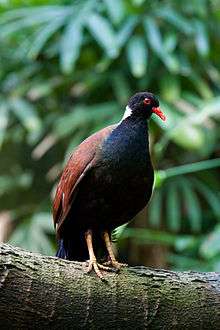Pheasant pigeon
The pheasant pigeon (Otidiphaps nobilis) is a species of large terrestrial pigeon. It is the only species of the monotypic genus Otidiphaps. The pheasant pigeon is found in the primary rainforests of New Guinea and nearby islands. It ranges primarily over hilly and lower mountain areas, but can also be found in lowlands.
| Pheasant pigeon | |
|---|---|
 | |
| O. n. aruensis | |
| Scientific classification | |
| Kingdom: | Animalia |
| Phylum: | Chordata |
| Class: | Aves |
| Order: | Columbiformes |
| Family: | Columbidae |
| Genus: | Otidiphaps Gould, 1870 |
| Species: | O. nobilis |
| Binomial name | |
| Otidiphaps nobilis Gould, 1870 | |
Taxonomy and systematics
The genus name makes reference to its similarities to the bustard family (Otidae). Its common name reflects its adaptation to living on the forest floor in the fashion of a South East Asian pheasant.
Subspecies
Commonly, there are four subspecies recognized that differ primarily in the presence or absence of a small crest and in the colour of the nape:[2]
- White-naped pheasant pigeon (O. n. aruensis) – Rothschild, 1928: Found on the Aru Islands, Vulnerable[3]
- Green-naped pheasant pigeon (O. n. nobilis) – Gould, 1870: Found on western New Guinea, Batanta and Waigeo Islands, Least concern[4].
- Grey-naped pheasant pigeon (O. n. cervicalis) – Ramsay, EP, 1880: Found on eastern and south-eastern New Guinea, Least concern[5].
- Black-naped pheasant pigeon (O. n. insularis) – Salvin & Godman, 1883: Found on Fergusson Island, Endangered[6].
Some authors however recognize the 4 subspecies as 4 different species, a classification scheme followed by the IUCN.[7][4]
Description
The pheasant pigeon resembles a pheasant in external morphology, particularly in its laterally compressed tail and the rounded wings. No galliform birds occur in New Guinea, and the pheasant pigeon has filled the ecological niche of a partridge or small pheasant (while the larger Goura crowned pigeons have a lifestyle similar to larger pheasants, grouse or turkeys). It is a highly secretive species, feeding on seeds and fallen fruits. It nests on the ground below trees and bushes, laying one egg that it incubates for around four weeks.
 O. n. nobilis
O. n. nobilis O. n. nobilis in a zoo
O. n. nobilis in a zoo O. n. insularis
O. n. insularis Captive O. n. aruensis (vulnerable)
Captive O. n. aruensis (vulnerable)
Status and conservation
The green-naped pheasant pigeon (nominate subspecies) and the grey-naped pheasant pigeon are not considered threatened, although the black-naped pheasant pigeon is considered endangered and the white-naped pheasant pigeon is vulnerable. Because it is tied to primary forests, and is unique within the pigeon family, it is considered a genus that requires further investigation and monitoring.
References
- BirdLife International (2016). "Otidiphaps nobilis". IUCN Red List of Threatened Species. 2016. Retrieved 4 February 2018.CS1 maint: ref=harv (link)
- Gill, Frank; Donsker, David, eds. (2018). "Pigeons". World Bird List Version 8.1. International Ornithologists' Union. Retrieved 4 February 2018.
- BirdLife International. 2016. Otidiphaps aruensis. The IUCN Red List of Threatened Species 2016: e.T22728031A94968761. https://dx.doi.org/10.2305/IUCN.UK.2016-3.RLTS.T22728031A94968761.en. Downloaded on 11 April 2018.
- BirdLife International. 2016. Otidiphaps nobilis. The IUCN Red List of Threatened Species 2016: e.T22725247A94888276. https://dx.doi.org/10.2305/IUCN.UK.2016-3.RLTS.T22725247A94888276.en. Downloaded on 11 April 2018.
- BirdLife International. 2016. Otidiphaps cervicalis. The IUCN Red List of Threatened Species 2016: e.T22725258A94888451. https://dx.doi.org/10.2305/IUCN.UK.2016-3.RLTS.T22725258A94888451.en. Downloaded on 11 April 2018.
- BirdLife International. 2016. Otidiphaps insularis. The IUCN Red List of Threatened Species 2016: e.T22726273A94916466. https://dx.doi.org/10.2305/IUCN.UK.2016-3.RLTS.T22726273A94916466.en. Downloaded on 11 April 2018.
- Comparison of IOC 8.1 with other world lists, by IOC World Bird List: http://www.worldbirdnames.org/ioc-lists/master-list-2/
- del Hoyo, Elliott and Sargatal (editors); Handbook of the Birds of the World, Vol 4. ISBN 84-87334-22-9
| Wikimedia Commons has media related to Otidiphaps nobilis. |
